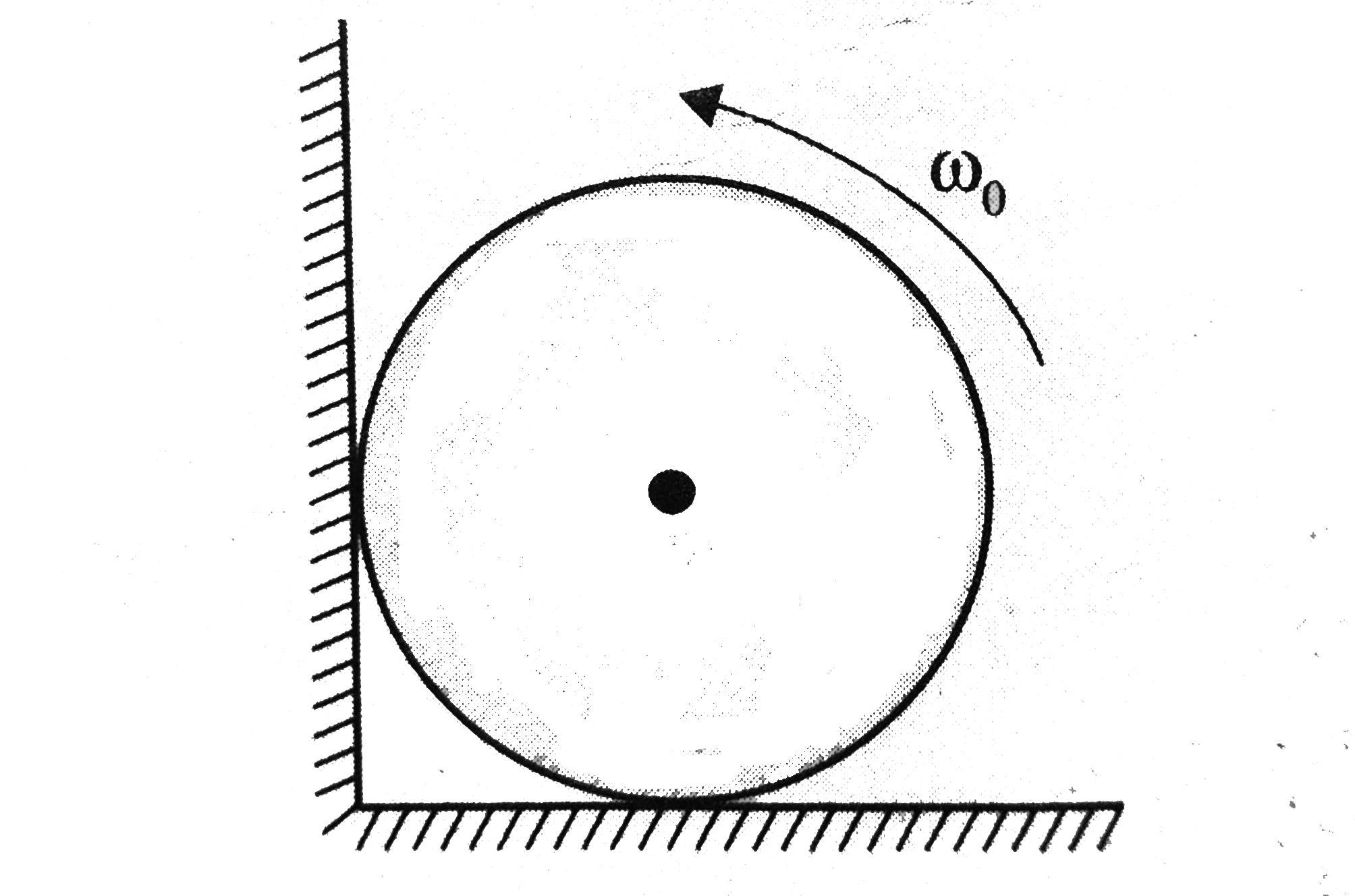A unifom cylinder of steel of mass M radius R is placed on frictionless bearings and sct to rotate about its axis with angular velocity ω0 After the cylinder has reached the specified state of rotation, it is heated from temperature T0→(T0+ΔT) without any mechanical contact. If (DeltaI)/I is the fractional change in moment of inertia of the cylinder and Δωω0 be the fractional change in the angular velocity of the cylinder and alpha be the coefficient of linear expansion, then
ΔII=2ΔRR
ΔII=2Δωω0
Δωω0=−2αΔT
ΔII=−2ΔRR
The correct Answer is:A, C
I=MR22 & M is constant Rightarrow IαR2
:.ΔII=2(ΔRR)=2α(ΔT) on heating also no external torque present :.L=Iw=constant
w α1I
:.Δww=−ΔII=−2(ΔRR)=−2α(ΔT)
Topper's Solved these Questions
- BOOK - BANSALCHAPTER - MASTER PRACTICE PROBLEMEXERCISE - Subjective107videos
MASTER PRACTICE PROBLEM
- BOOK - BANSALCHAPTER - MASTER PRACTICE PROBLEMEXERCISE - Additional topic70videos
MASTER PRACTICE PROBLEM
- BOOK - BANSALCHAPTER - MASTER PRACTICE PROBLEMEXERCISE - Reasoning75videos
MASTER PRACTICE PROBLEM
- BOOK - BANSALCHAPTER - FLUID MECHANICSEXERCISE - PYQS AIEEE10videos
FLUID MECHANICS
- BOOK - BANSALCHAPTER - SEMICONDUCTORSEXERCISE - CBSE Question32videos
SEMICONDUCTORS
Similar Questions
In a given system of unit standard measurement of mass is 100 gm standard measurement of length is 200 cm and standard measurement of time is 5 sec 10 J energy in the given system of unit has value N, then value of N is
06:56View SolutionThe manifestation of band structure in solids is due to
01:51View SolutionStatement-1: The numerical value (n)of a physical quantity is inversely proportional to size of unit (u) being used to measure it.
Statement-2:The magnitude of physical quantity does not change by changing the units.06:17View SolutionA cylinder of height 20m is completely filled with water. The velocity of effux of water (∈ms−1) through a small hole on the side wall of the cylinder near its bottom is
05:43View SolutionHow does the width of the depletion layer of a p-n junction diode change with decrease in reverse bias?
06:18View SolutionA uniform cylinder of radius R is spinned about it axis to the angular velocity ω0 and then placed into a corner,. The coeficient of friction between the corner walls and the cylinder is μk How many turns will the cylinder accomplish before it stops?
 02:42View Solution
02:42View SolutionA mass is supported on a frictionless horizontal surface. It Is attached to a string and rotates about a fixed center at an angular velocity omega_(0) .If the length of the string and angular velocity both are doubled, the tension in the string which was initially T_(0) is now
04:30View SolutionA uniform solid brass cylinder of mass M=0.5Kg and radius R=0.03m is placed in frictionless bearings and set to rotate about its geometrical axis with an angular velocity of 60rads. After the cylinder has reached the specified state of rotation, it is heated (without any mechanical contact) from room temperature 200C to 1000C. The fractional change in angular velocity of the cylinder is (α=2×10−5/0C)sss
05:45View SolutionAs per the shown figure the central solid cylinder starts with initial angular velocity omega_(0) Find the time after which the angular velocity becomes half.
08:19View SolutionTwo cylinders having radiii R_(1) and R_(2) and rotational inertia I_(1) and I_(2) respectively, are supported by fixed axes perpendicular to the plane of figure-5.52. The large cylinder is initially rotating with angular velocity omega_(0) . The small cylinder is moved to the right until it touches the large cylinder and is caused to rotate by the frictional force between the two. Eventually, slipping ceases, and the two cylinders rotate at constant rates in opposite directions, (a) Find the final angular velocity omega_(2) of the small cylinder in terms of I_(1) , I_(2) , R_(1) , R_(2) and omega_(0) . (b) Is total angular momentum conserved in this case ?
View SolutionA solid cylinder of mass 20 kg rotates about its axis with angular velocity of 100 radian s^(-1) . The radius of the cylinder is 0.25m . The magnitude of the angular momentum of the cylinder about its axis of rotation is
View SolutionA solid cylinder of mass 'M' and radius 'R' is rotating along its axis with angular velocity omega without friction. A particle of mass 'm' moving with velocity v collides aganist the cylinder and sticks to its rim. After the impact calculate angular velocity of cylinder .
03:51View SolutionA uniform cylinder of the radius R ( = 3 m) is spin about its axis at an angular velocity omega_(0)(=40 sqrtpi" rad s"^(-1)) and placed between two perpendicular walls. The coefficient of friction between the walls and cylinder is mu(=2). Then, how many rotations will the cylinder make before it comes to rest?
View SolutionA cylinder is rotating with angular velocity omega_(0) and is gently put on a rough horizontal floor. Assume mass of the cylinder is m and radius R. Calculate the velocity of cylinder when it starts pure rolling on the surface.
View SolutionA circular disc rotates freely about a vertical axis through its centre with angular velocity ω1. A ring having the same mass and radius as the disc is placed on the disc and the system now rotates with an angular velocity ω2 about the same vertical axis. Then ω2/ω1 is:
09:06View Solution

